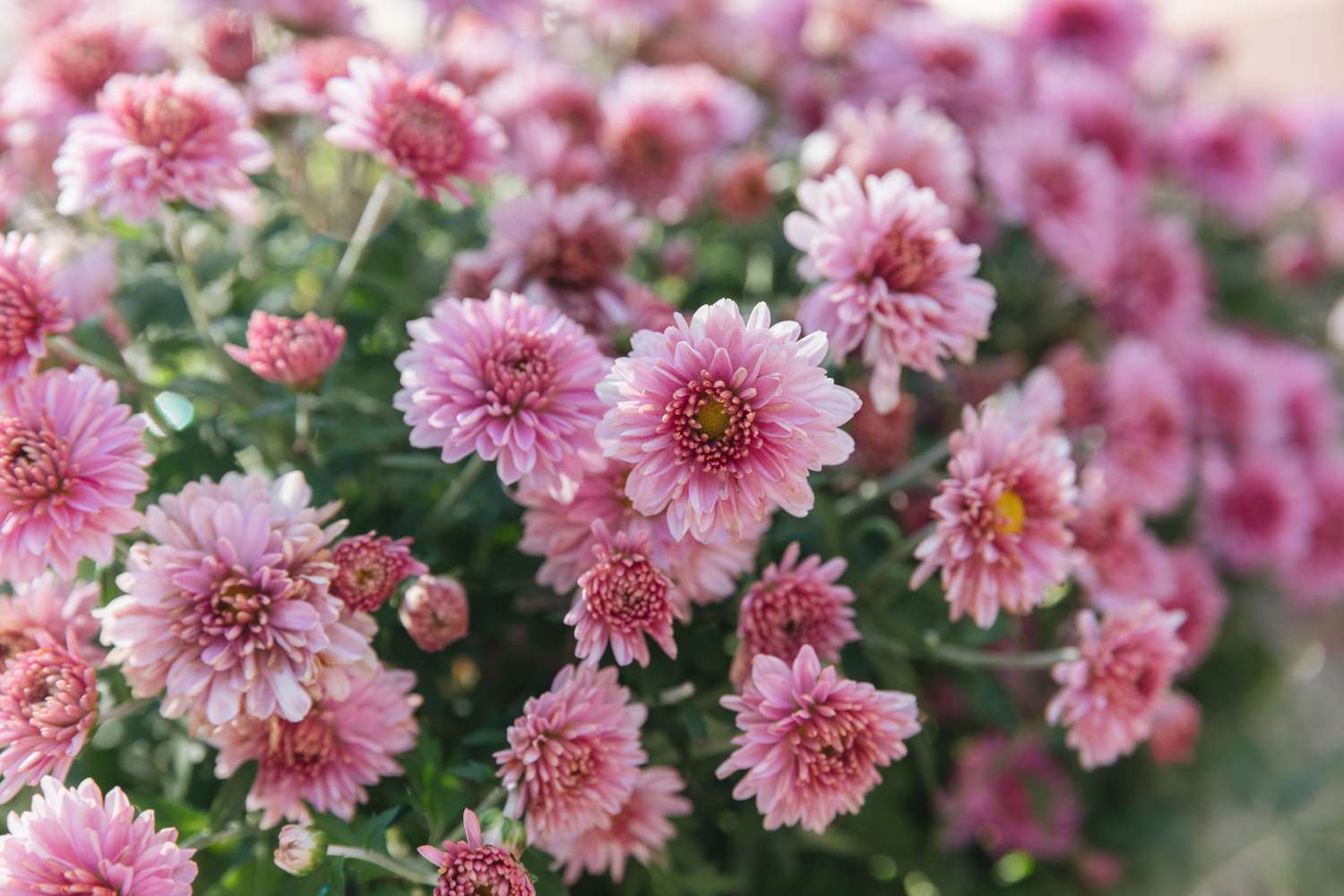The Complete Guide to Chrysanthemum Gardens: Cultivating Autumn’s Crown Jewel in the UK
As summer blooms fade and the air turns crisp, there’s one flower that rises to prominence in British gardens—the chrysanthemum. With their rich jewel tones and remarkable diversity of forms, these autumn treasures provide a much-needed burst of color when most plants are preparing for dormancy. Whether you’re a seasoned gardener or a novice looking to extend your garden’s seasonal interest, chrysanthemums offer an accessible way to maintain vibrant displays well into the colder months.
This comprehensive guide explores everything you need to know about cultivating hardy chrysanthemums in UK gardens, from selecting the right varieties to year-round care techniques that ensure these resilient perennials return with increasing splendor each season.
Understanding Chrysanthemums: A Brief Introduction
Native to East Asia, chrysanthemums (often affectionately called “mums”) belong to the Asteraceae family and have been cultivated for over 2,500 years. The name derives from the Greek words “chrysos” (gold) and “anthemon” (flower), referring to the original golden-yellow varieties first cultivated in China.
In the UK, chrysanthemums have been deeply embedded in garden culture since Victorian times, with their popularity experiencing a significant revival in recent years as gardeners rediscover their remarkable durability and seasonal impact.
Types of Chrysanthemums for UK Gardens
Not all chrysanthemums are created equal when it comes to garden performance. For successful outdoor cultivation in British conditions, focus on these categories:
Hardy Garden Chrysanthemums
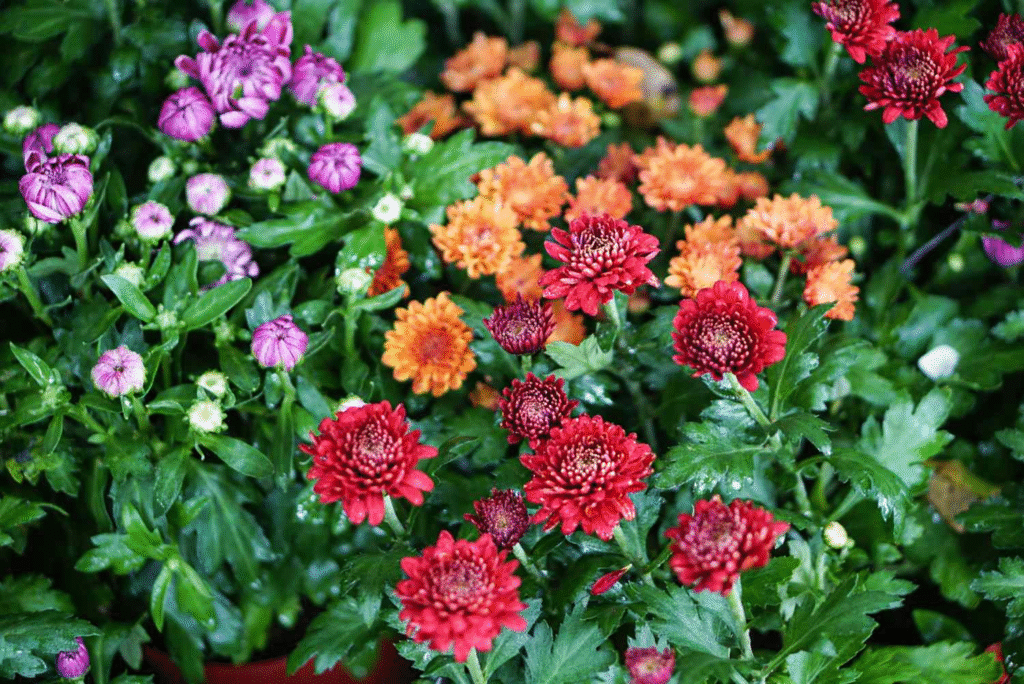
These robust perennials are specifically bred to withstand UK winters and return year after year. Key characteristics include:
- Sturdy, compact growth habits (typically 40-80cm tall)
- Early to mid-autumn flowering (before heavy frosts)
- Strong root systems that survive winter conditions
- Less demanding maintenance requirements
Korean Chrysanthemums
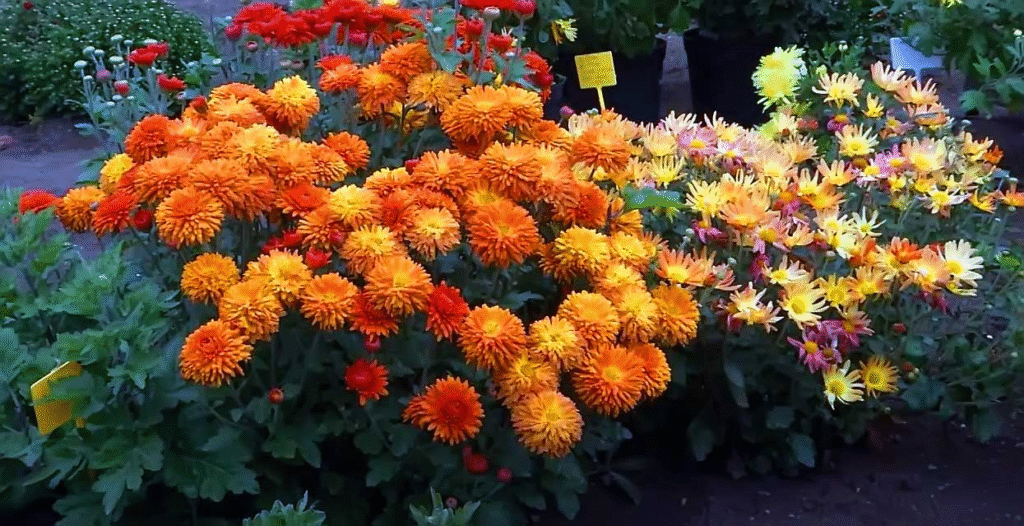
A subset of hardy garden mums, Korean varieties are renowned for their exceptional cold tolerance, making them ideal for northern UK gardens:
- Extremely winter-hardy (surviving temperatures down to -20°C in some cases)
- Single or semi-double daisy-like flowers
- Naturalistic appearance that blends well with cottage garden styles
- Earlier blooming period (often starting in September)
Rubellum Chrysanthemums
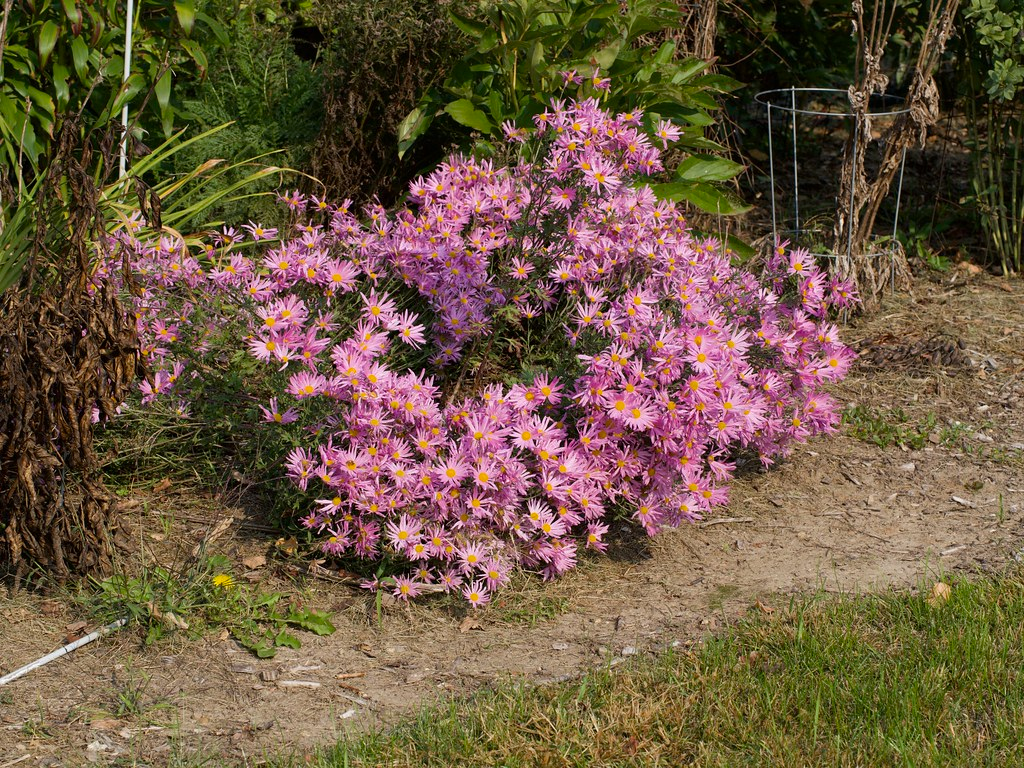
These varieties are prized for their elegant, simple flowers and exceptional hardiness:
- Open-centered, single flowers with distinctive central discs
- Strong stems that rarely need staking
- Good resistance to wind and rain damage
- Excellent for border plantings and cutting gardens
Selecting the Perfect Site for Your Chrysanthemum Garden
The foundation of successful chrysanthemum cultivation lies in proper site selection. Consider these factors when choosing where to place your mums:
Sunlight Requirements
Chrysanthemums perform best with:
- Full sun (6+ hours of direct sunlight daily)
- Morning sun with light afternoon shade in hotter regions
- Protection from intense midday sun in southern UK gardens
Soil Conditions
For optimal growth, provide:
- Well-draining soil (crucial for winter survival)
- Slightly acidic to neutral pH (6.0-7.0)
- Rich, organic matter that retains moisture without becoming waterlogged
- Loamy texture that allows for good root development
Protection from Elements
Consider these environmental factors:
- Shelter from strong prevailing winds
- Protection from frost pockets
- Good air circulation to prevent fungal issues
- Access to water sources for irrigation during establishment
Planting Hardy Chrysanthemums for Success
Timing and technique are everything when establishing chrysanthemums that will truly thrive for years.
When to Plant
The single most important factor in growing perennial chrysanthemums is planting at the right time:
- Early to mid-spring (April to May) is optimal for UK gardens
- This allows plants to establish strong root systems before flowering
- Avoid autumn planting of small plants if possible, as they may not survive their first winter
- If you must plant in autumn, choose larger, well-established plants
Planting Process
Follow these steps for successful chrysanthemum establishment:
- Prepare the soil thoroughly by digging in compost or well-rotted manure
- Space plants 40-60cm apart (depending on variety) to ensure good air circulation
- Plant at the same depth as they were in their containers
- Water well after planting and regularly for the first 2-4 weeks
- Apply a balanced fertilizer at planting time to encourage strong root development
Year-Round Care Guide for UK Chrysanthemums
Successful chrysanthemum cultivation requires different approaches throughout the growing cycle. This seasonal calendar outlines essential care tasks.
Spring Care (March-May)
This is the critical period for setting up your chrysanthemums for success:
- Division: Every 2-3 years, divide established clumps in early spring when new growth reaches 10-15cm
- New plantings: Ideal time to introduce new varieties to your garden
- Feeding: Apply a balanced fertilizer (like 10-10-10) when new growth appears
- Weeding: Keep the area around young plants free from competition
- Pest control: Monitor for early signs of aphids and deal with promptly
Summer Care (June-August)
Focus on these tasks during the growing season:
- Pinching: To encourage bushier plants, pinch out growing tips until mid-July (stop earlier for earlier-flowering varieties)
- Watering: Provide consistent moisture during dry periods, focusing on deep watering rather than frequent light sprinkles
- Feeding: Apply a high-potassium fertilizer (like tomato feed) every 2-3 weeks to promote strong flower development
- Staking: Install support for taller varieties before they reach full height
- Pest management: Regular checks for aphids, spider mites, and earwigs
Autumn Care (September-November)
As flowering begins, adjust your care routine:
- Deadheading: Remove spent blooms to encourage additional flowering
- Watering: Reduce frequency but maintain moisture during dry periods
- Protection: Be prepared to cover plants during early frosts if buds are still developing
- Cutting: Enjoy cut flowers but leave some stems for winter structure
- Mulching: Apply a protective mulch around plant bases as temperatures drop
Winter Care (December-February)
Proper winter protection is essential for perennial performance:
- Do not cut back foliage until spring—leave the stems to protect the crown
- Apply a thick mulch (5-10cm) of compost, leaf mold, or straw around the base
- Provide drainage to prevent crown rot in wet winters
- Consider lifting precious varieties in very cold or wet regions, storing in cold frames
- Check occasionally for signs of rot or pest damage
Common Problems and Solutions for UK Chrysanthemum Gardens
Even these resilient plants can face challenges in British growing conditions. Here are common issues and their solutions:
Pest Management
Aphids
- Signs: Distorted new growth, sticky residue on leaves
- Solution: Encourage beneficial insects, use organic soap sprays, or manually remove with a strong water spray
Earwigs
- Signs: Ragged holes in petals and leaves
- Solution: Create simple traps using upturned pots filled with straw, or use diatomaceous earth around plants
Chrysanthemum Eelworm
- Signs: Distorted, stunted growth with blackened leaves
- Solution: Remove and destroy affected plants, practice crop rotation, and source clean stock
Disease Prevention
Powdery Mildew
- Signs: White powdery coating on leaves
- Solution: Improve air circulation, avoid overhead watering, apply fungicidal treatments early
Chrysanthemum White Rust
- Signs: Yellow patches on upper leaf surfaces with white pustules underneath
- Solution: Remove affected foliage, ensure good airflow, and avoid wetting leaves when watering
Crown and Root Rot
- Signs: Wilting despite adequate moisture, discolored stems at soil level
- Solution: Ensure excellent drainage, avoid overwatering, and consider raising beds in wet areas
Best Hardy Chrysanthemum Varieties for UK Gardens
Based on performance in British conditions, these varieties consistently deliver outstanding results:
Early-Flowering Varieties (September-Early October)
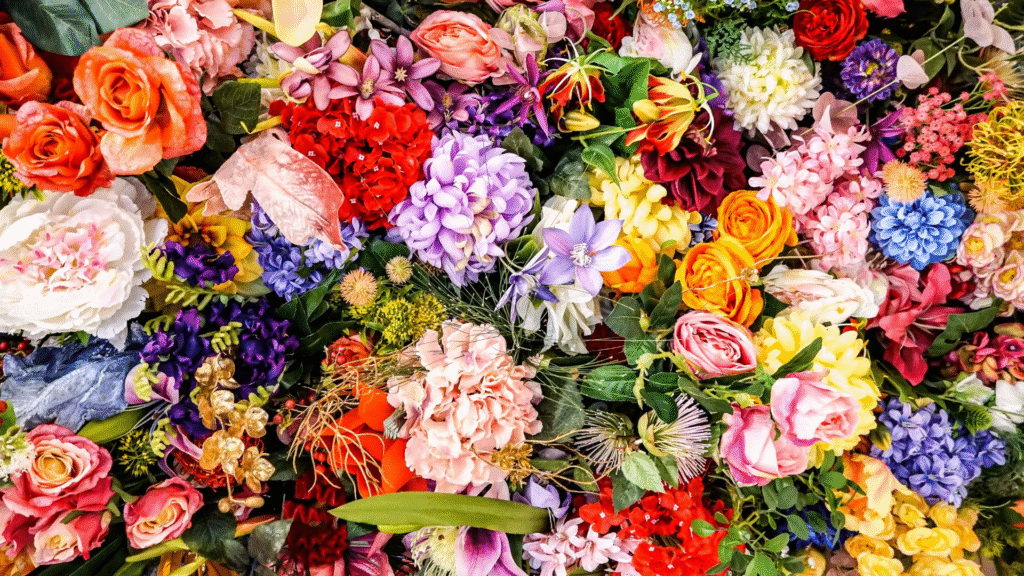
- ‘Emperor of China’ – Ancient pink variety with incurved petals, excellent hardiness
- ‘Ruby Mound’ – Rich ruby-red double flowers, compact habit reaching 60cm
- ‘Chelsea Physic Garden’ – Single salmon-pink blooms with excellent weather resistance
Mid-Season Varieties (October)
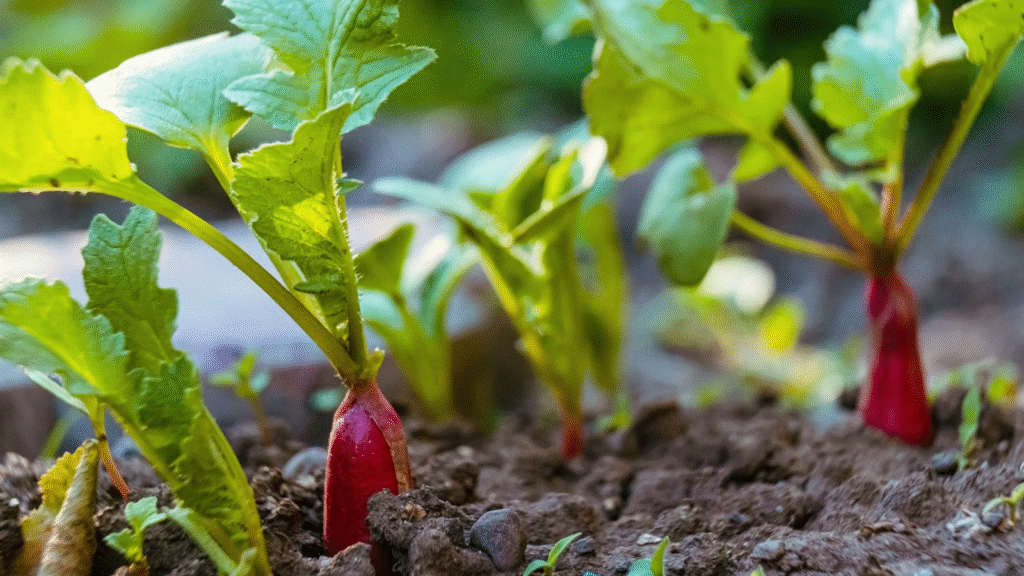
- ‘Mei-kyo’ – Small, perfect pompom flowers in lavender-pink, extremely hardy
- ‘Bronze Elegance’ – Bronze-orange double blooms that darken with age, reaches 70cm
- ‘Cottage Bronze’ – Rusty orange semi-double flowers, exceptional durability
Late-Season Varieties (Late October-November)
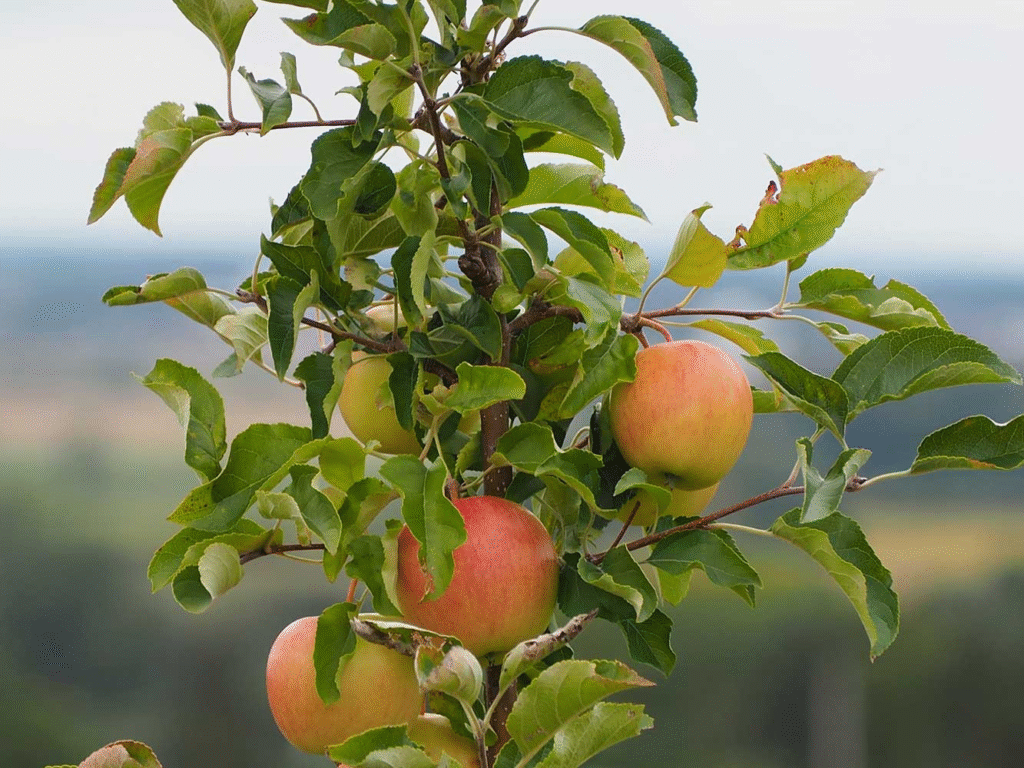
- ‘Duchess of Edinburgh’ – Large white blooms with incurved petals, historic variety
- ‘Mary Stoker’ – Soft yellow daisy-like flowers that age to apricot, reaches 80cm
- ‘Anastasia’ – Spider-type with pendant bronze petals, architectural presence
Chrysanthemums Beyond the Garden: Cultural Significance
Beyond their ornamental value, chrysanthemums carry rich cultural meanings that enhance their garden presence:
Global Symbolism
In the UK, chrysanthemums traditionally symbolize friendship, support, and well-wishing, making them thoughtful gifts. Their associations vary worldwide—in Japan, they represent the imperial family and longevity, while in many European countries, they’re associated with remembrance and are often used in memorial arrangements.
Chrysanthemum Translation Across Cultures
The Japanese word for chrysanthemum is “kiku” (菊), and it holds special significance as Japan’s imperial emblem. The flower was introduced to Japan from China around the 5th century and became the symbol of the Emperor, featuring in the imperial crest with a distinctive 16-petal design.
Conclusion: Creating Your Chrysanthemum Sanctuary
Establishing a chrysanthemum garden in the UK offers rewards that extend far beyond the typical growing season. These adaptable plants bring structure, color, and life to autumn gardens when most other flowers have faded. By following the guidance provided in this comprehensive guide, you’ll be well-equipped to cultivate healthy, vibrant chrysanthemums that return with increasing beauty year after year.
Whether you dedicate an entire border to these fall stars or integrate them throughout your garden for seasonal impact, hardy chrysanthemums deserve a place in every British garden. Their resilience, diversity, and timeless appeal make them not merely plants but living connections to centuries of horticultural tradition—true classics that continue to captivate gardeners with each autumn’s grand finale.
